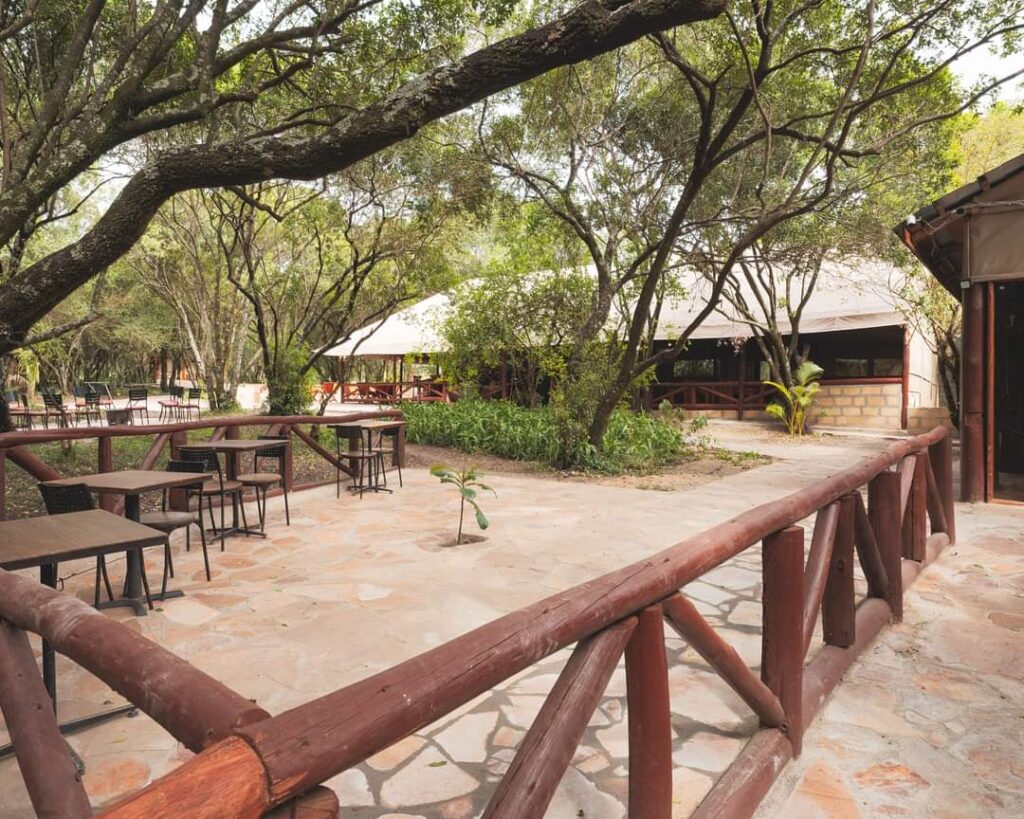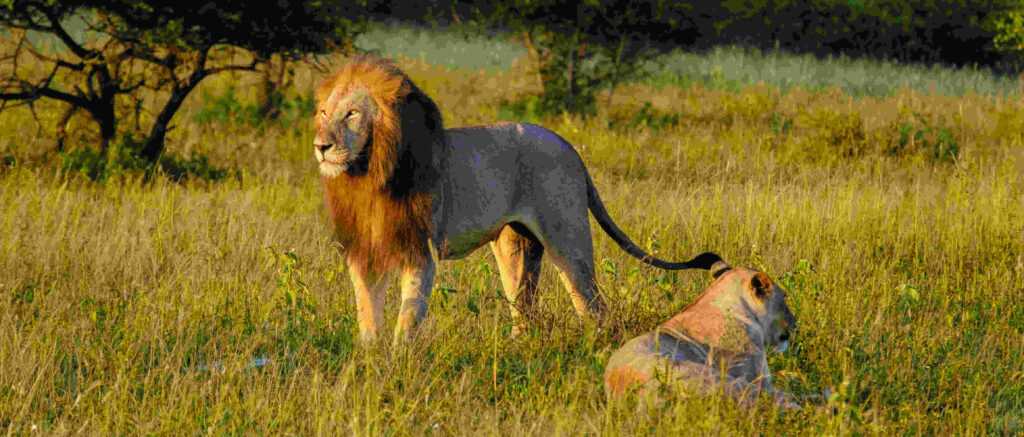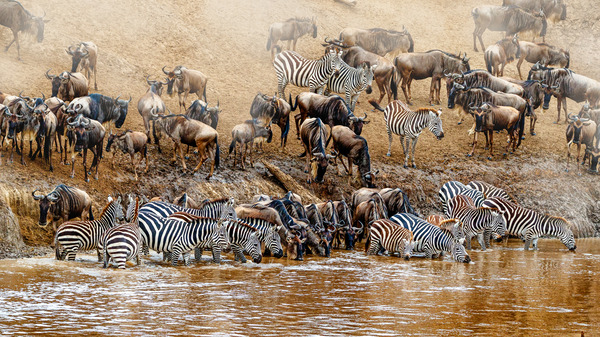Are you ready for an adventure? Imagine witnessing the awe-inspiring spectacle of the Great Migrating Wildebeest. The Migration occurs in the vast Masai Mara plains. You will observe millions of wildebeest, zebras, and antelopes chased by ferocious predators. It’s a once-in-a-lifetime experience that you won’t forget.
The Wildebeest Migration is a yearly cycle of events as ancient as time. Yet still new and awe-inspiring to witness today. With a Masai Mara safari, you’ll explore this unique part of the world at its peak season. Migrating Wildebeest often occurs during the drier months between July and October. You will Travel through some of Kenya’s most stunning landscapes. This is where you will spot wildlife all along the way.
Let me show you around the Masai Mara and explain why it’s one of the best places in Africa to experience wildlife.
1. Overview of the Wildebeest Migration
The Wildebeest Migration is one of nature’s most incredible spectacles. It occurs yearly between the Serengeti National Park in Tanzania and the Masai Mara National Reserve in Kenya. This incredible wildlife spectacle involves millions of wildebeest, zebras, and gazelles. You will observe them moving across the vast plains of East Africa in search of grass and water.
The Migration is a continuous cycle, with the herds moving in search of greener pastures. The journey begins in the Southern Serengeti in Tanzania. This is where the herds graze on the nutrient-rich grasslands. The grass becomes scarce as the dry season sets in, and the packs move toward the north. The herds will cross the Mara River into the famous Masai Mara in Kenya. They will spend several months feasting on the lush grasses here before returning to the Serengeti.

The Migration is not only a fascinating spectacle to witness but also an important event for the survival of many species. Predators such as lions, cheetahs, and hyenas follow the herds. You will often see them preying on the weaker animals. Migration also plays a vital role in maintaining the region’s ecological balance. It’s observed when the herds’ constant movement helps fertilize the soil and spread seeds. This will also promote new growth.
Between July and October, the herds are at their largest and have crossed the Mara River. This will be the ideal time to see the Migrating Wildebeest in the Masai Mara. During these months, predators are also the most active. Their presence will also provide an excellent opportunity for wildlife viewing.
Every nature enthusiast should put seeing the Migrating Wildebeest on their bucket list since it is a magical event.
2. What You Need to Know Before Your Wildebeest Migration Safari
You should know things before going on a safari to see the Migrating Wildebeest in Masai Mara. Here are some key considerations:
1. Timing: The Wildebeest Migration is seasonal from July to October. Plan your trip during this time to maximize your chances of witnessing the Migration.
2. Accommodation: Various accommodations are available in and around Masai Mara. They usually range from luxury lodges to camping sites. Book your accommodation in advance, as it can fill up during the peak season.

3. Clothing: The weather in the Masai Mara can be unpredictable. This clothing includes warm layers for early morning game drives. Having a waterproof jacket and sturdy walking shoes will also be vital.
4. Photography equipment: During this safari, you will plan to capture the magic of the Migrating Wildebeest . Bring a good quality camera with a zoom lens and plenty of memory cards and batteries.
5. Health and safety: The Masai Mara is a remote wilderness area, and it’s essential to take precautions to ensure your health and safety. Ensure you have up-to-date vaccinations and pack insect repellent. Also, follow your guide’s instructions to minimize the risk of illness or injury.
6. Cultural considerations: The Masai Mara is home to the Maasai people with a rich and unique culture. Ensure you respect their traditions and customs. Always ask for permission before photographing people.
7. Safari etiquette: During your safari, following the rules and guidelines set by your guide is essential. Controls also include always staying in the vehicle and keeping a safe distance from wildlife. Also, refraining from littering or disturbing the environment will sh.
Consider these factors before you embark on your safari. You will have a safe, enjoyable, and unforgettable experience. You will witness the world’s famous Wildebeest Migration in Masai Mara.
3. The Magic of the Migrating Wildebeest
The Wildebeest Migration is an awe-inspiring event showcasing nature’s incredible power and resilience. Watching the vast herds of wildebeest and zebras moving across the open plains is a humbling experience. The Migration is a true testament to the instincts of these animals, who know when and where to move to find food and water.
The river crossings highlight the Migration. This comes as the herds must navigate through crocodile-infested waters. Crossing the Mara River often results in dramatic scenes of struggle and survival. The sight of thousands of animals demonstrates the perseverance and toughness of these animals. The animals dash through the water while crocodiles lurk below the surface.

The Wildebeest Migration is not about the wildebeest, though. The event supports a diverse ecosystem of predators. The predators include lions, cheetahs, leopards, and hyenas. They will follow the herds and prey on weaker or injured animals. The sheer number of animals involved in the Wildebeest Migration also means the Migration impacts the region’s ecology. This will help to fertilize the soil and promote new growth.
Visiting the Masai Mara during the Migrating Wildebeest is an unforgettable experience. This Kenyan safari will allow you to witness one of nature’s greatest spectacles, whether you are a seasoned wildlife enthusiast or appreciate the beauty and power of the natural world. The Migrating Wildebeest is a must-see event.
4. When to Visit for the Wildebeest Migration
July and October is the ideal time to see the Wildebeest Migration in the Masai Mara. The Masai Mara is home to herds during this time, and you will likely observe the famous river crossings.
In July, the herds arrive in the Masai Mara, having crossed over from the Serengeti in Tanzania. August is usually the best time to witness the dramatic river crossings as the herds attempt to cross the Mara River. September and October are also great months to visit. This comes as the packs start to move back towards the Serengeti, providing a chance to see the animals in large numbers on the move.
It’s worth noting that the exact timing of the Migration can vary from year to year. Additionally, it can be affected by factors such as rainfall patterns and grazing conditions. Thus, checking with local guides or tour operators is always a good idea to ensure you plan your visit during the peak migration season.
While Migrating Wildebeest is the main attraction, the Masai Mara is a year-round destination. It also comes with excellent wildlife viewing opportunities. Suppose you can’t visit during the migration season. In that case, you can still see abundant wildlife. These include the Big Five (lions, elephants, leopards, rhinos, and buffalos) and other species, such as giraffes, zebra, and hippos.
5. What to Expect When You Arrive
When you arrive in the Masai Mara for the Wildebeest Migration, you can expect to be greeted by vast, open plains teeming with wildlife. The Masai Mara is a beautiful and wild place where the sounds of nature fill the air, and the sight of wildlife is an everyday occurrence.
You’ll first notice the warm hospitality of the locals, who will welcome you to their community and ensure a memorable stay. You’ll also be able to immerse yourself in the local culture. You will have an opportunity to visit traditional Maasai villages and learn about their way of life.
When it comes to wildlife viewing, the Masai Mara is one of the best destinations in Africa. Predators like lions, cheetahs, and hyenas are likely to be present, along with sizable herds of wildebeest, zebras, and gazelles. You may also spot elephants, giraffes, hippos, and various bird species.
Game drives are popular; you can expect to set out early in the morning and late in the afternoon when wildlife is most active. You may also have the opportunity to participate in guided walks, hot air balloon rides, and cultural experiences.
Accommodation options in the Masai Mara range from luxurious lodges and tented camps to more basic campsites. This depends on your preferences and budget.
When you arrive in the Masai Mara, you can expect an unforgettable wildlife experience. You will get warm hospitality and the chance to immerse yourself in the rich culture of the Maasai people.
6. Where to Witness the Migrating Wildebeest Spectacle
One of Kenya’s most incredible locations to see the Migrating Wildebeest is at Maasai Mara National Reserve. The reserve covers an area of 1,500 square kilometres. Masai Mara is also home to diverse wildlife, including the Big Five, giraffes, hippos, and various bird species.
Within the Masai Mara National Reserve, there are several areas where you can witness the Migration. The Mara River runs through the reserve and is a trendy spot where the herds must cross to move between Kenya and Tanzania. You can witness The river crossings from the banks of the river or from a hot air balloon, which provides a bird’s eye view of the action.
There are also private reserves and conservancies in the area. These reserves offer excellent wildlife viewing opportunities. They are often with fewer visitors than the national reserve. These areas have more exclusive lodges and camps. They offer a more luxurious and intimate safari experience.
Ultimately, where to witness the Migrating Wildebeest depends on personal preference and budget. However, the Masai Mara National Reserve remains one of the most popular and accessible options. This national reserve provides an unforgettable wildlife experience.
7. What Animals Can You Expect to See?
One of the best areas in Africa to witness various animals is the Masai Mara National Reserve. The following animals can be seen during the annual wildebeest migration:


- Wildebeest: The Great Wildebeest Migration is named after these animals. You will see them in vast herds numbering in the hundreds of thousands.
- Zebras: Zebras often go with the wildebeest during their Migration. Their black and stripes contrast sharply against the savannah grasslands.
- Lions: The Masai Mara is known for its healthy lion population. You will have a chance to see them hunting the wildebeest and other prey.
- Cheetahs: The open grasslands of the Masai Mara provide an ideal habitat for cheetahs. You can often see them hunting and stalking their prey.
- Elephants: The Masai Mara is home to large elephant herds, which can be seen feeding on acacia trees and other vegetation.
- Giraffes: The tall and elegant giraffes can often be seen browsing on the trees and bushes of the savannah.
- Hippos: The Mara River runs through the reserve and is home to a large population of Nile crocodiles. They often wait for the wildebeest as they cross the river.
- Hyenas: These scavengers can often be seen patrolling the savannah, looking to steal a meal from other predators.
- Buffalo: These large and powerful animals can often be seen in large herds, grazing on the grasslands of the Masai Mara.
Also, to these animals, the Masai Mara is home to various bird species, including vultures, eagles, storks, and ostriches. The diverse range of wildlife makes the Masai Mara an extraordinary and unique destination for a safari.
8. Tips for Capturing the Migrating Wildebeest on Camera
Capturing the Migrating Wildebeest on camera can be a challenging but rewarding experience. The following advice will help you take the most outstanding pictures:
1. Use a telephoto lens: A telephoto lens will allow you to zoom in on the action and get close-up shots of the animals. A lens with a focal length of at least 300mm is recommendable.
2. Use a fast shutter speed: To freeze the action and capture sharp images, use a faster shutter speed of at least 1/1000s or higher.
3. Use a tripod or monopod: A stable support like a tripod or monopod will help you to keep your camera steady, especially when using a telephoto lens.
4. Be patient and observant: The Migration is unpredictable, and it may take some time to witness a river crossing or other dramatic events. Have patience and keep an eye out for any motion or activity.
5. Consider the lighting: The early morning and late afternoon light can be wonderful and provide a warm glow to your images. Avoid harsh midday sunlight, resulting in harsh shadows and overexposed highlights.
6. Capture the scale: The Migration is a vast spectacle, essential to capture the sense of scale and movement. To provide context and perspective, try to include elements such as the landscape, other animals, and the sky.
7. Tell a story: Think about the story you want to tell with your image. Consider capturing the animals’ behaviour and the river crossings’ drama. You will also tell a story about the interactions between different species.
Remember, wildlife photography is about being in the right place at the right time, and sometimes luck plays a significant role. These pointers can help you improve your chances of getting breathtaking shots of the Wildebeest Migration.
9. The Benefits of a Guided Tour
Tour guides can offer several benefits when visiting the Masai Mara for the Wildebeest Migration. Here are some of the advantages of taking a guided tour:
Expert knowledge: A guided tour is led by a professional guide with extensive knowledge of the area’s wildlife, culture, and history. Principles can also enhance your experience by providing in-depth information on wildlife.
Better wildlife sightings: Guides have an intimate knowledge of the migration patterns. They can also take you to the best spots to witness the action. They also have trained eyes for spotting wildlife that the untrained observer may miss.
Safety and security: A guided tour provides an added level of safety and security. Guides are also trained in wilderness first aid and can help you navigate potential hazards. They also know the best practice for minimizing risks when viewing wildlife.
Convenience: A guided tour takes care of all the logistics of your trip. These include transportation, accommodation, and meals. You can focus on enjoying your safari experience without worrying about the details.
Flexibility: A guided tour can be tailored to your interests and preferences. You can also choose from various activities. These activities include game drives, guided walks, cultural experiences, and hot air balloon rides.
Eco-tourism: Many guided tours are committed to eco-tourism principles. The priority includes sustainable and responsible tourism practices. These priorities minimize environmental impact and benefit local communities.
A guided tour can enhance your safari experience by providing expert knowledge. Also, it will enhance better wildlife sightings, safety, and security. Convenience, flexibility, and an eco-approach to tourism will also be enhanced.
